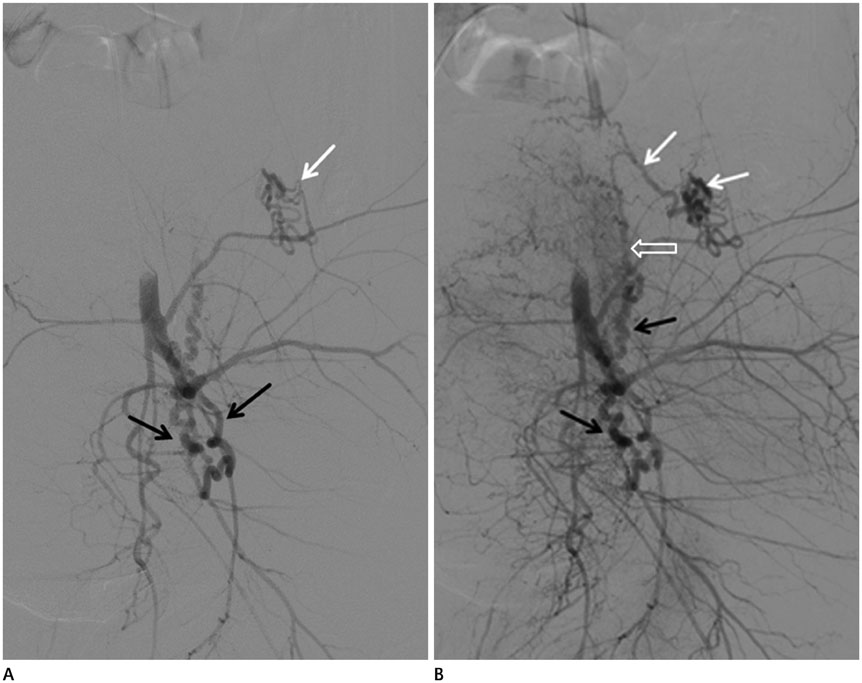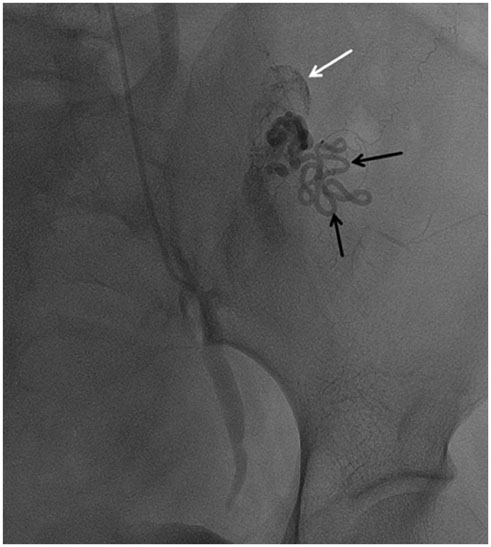J Korean Soc Radiol.
2016 May;74(5):339-343. 10.3348/jksr.2016.74.5.339.
Aberrant Ovarian Artery Originating from the Iliolumbar Artery: A Case Report
- Affiliations
-
- 1Department of Radiology, Soonchunhyang University College of Medicine, Bucheon Hospital, Bucheon, Korea. skyfill@schmc.ac.kr
- KMID: 2164832
- DOI: http://doi.org/10.3348/jksr.2016.74.5.339
Abstract
- Here, we report a case of a 30-year-old woman who presented with primary postpartum hemorrhage due to uterine atony. She received uterine artery embolization (UAE). During left internal iliac arteriography, an aberrant left ovarian artery originating from the left iliolumbar artery was visualized. The aberrant left ovarian artery was connected to the left uterine artery via prominent collateral vessels. It supplied a significant amount of blood to the fundus of the uterus. Bilateral hypertrophied uterine arteries were embolized very carefully so that the embolic material did not reflux into the aberrant left ovarian artery. After the procedure, her vaginal bleeding was successfully controlled. Accurate understanding of anatomical variations of the ovarian artery is essential to avoid failure in controlling postpartum hemorrhage with UAE.
MeSH Terms
Figure
Reference
-
1. Ganguli S, Stecker MS, Pyne D, Baum RA, Fan CM. Uterine artery embolization in the treatment of postpartum uterine hemorrhage. J Vasc Interv Radiol. 2011; 22:169–176.2. Kirby JM, Kachura JR, Rajan DK, Sniderman KW, Simons ME, Windrim RC, et al. Arterial embolization for primary postpartum hemorrhage. J Vasc Interv Radiol. 2009; 20:1036–1045.3. Matson M, Nicholson A, Belli AM. Anastomoses of the ovarian and uterine arteries: a potential pitfall and cause of failure of uterine embolization. Cardiovasc Intervent Radiol. 2000; 23:393–396.4. Smoger DL, Kancherla V, Shlansky-Goldberg RD. Uterine fundal blood supply from an aberrant left ovarian artery originating from the inferior mesenteric artery: implications for uterine artery embolization. J Vasc Interv Radiol. 2010; 21:941–944.5. Deux JF, Bazot M, Le Blanche AF, Tassart M, Khalil A, Berkane N, et al. Is selective embolization of uterine arteries a safe alternative to hysterectomy in patients with postpartum hemorrhage? AJR Am J Roentgenol. 2001; 177:145–149.6. Pelage JP, Walker WJ, Le Dref O, Rymer R. Ovarian artery: angiographic appearance, embolization and relevance to uterine fibroid embolization. Cardiovasc Intervent Radiol. 2003; 26:227–233.7. Kwon JH, Kim MD, Lee KH, Lee M, Lee MS, Won JY, et al. Aberrant ovarian collateral originating from external iliac artery during uterine artery embolization. Cardiovasc Intervent Radiol. 2013; 36:269–271.8. Kim WK, Yang SB, Goo DE, Kim YJ, Chang YW, Lee JM. Aberrant ovarian artery arising from the common iliac artery: case report. Korean J Radiol. 2013; 14:91–93.9. Reed RA, McLucas B. Aberrant right ovarian artery from proximal internal iliac artery in uterine artery embolization patient. Open J Radiology. 2012; 2:117–119.10. Wang MQ, Liu FY, Duan F, Wang ZJ, Song P, Song L. Ovarian artery embolization supplementing hypogastric-uterine artery embolization for control of severe postpartum hemorrhage: report of eight cases. J Vasc Interv Radiol. 2009; 20:971–976.
- Full Text Links
- Actions
-
Cited
- CITED
-
- Close
- Share
- Similar articles
-
- Aberrant Right Vertebral Artery Originating from the Aortic Arch Distal to the Left Subclavian Artery: A Case Report
- Two Cases of Aberrant Vertebral Artery Originating from Aortic Arch Distal to Left Subclavian Artery
- Aberrant Ovarian Artery Arising from the Common Iliac Artery: Case Report
- Coexistence of the Absence of the Left Common Carotid Artery, a Common Origin of the Left External Carotid Artery and the Right Common Carotid Artery, and an Aberrant Right Subclavian Artery: A Case Report
- A Case Report of Aberrant Bronchial Artery from Common Carotid Artery: A Potential Hazard in Bronchial Artery Embolization



